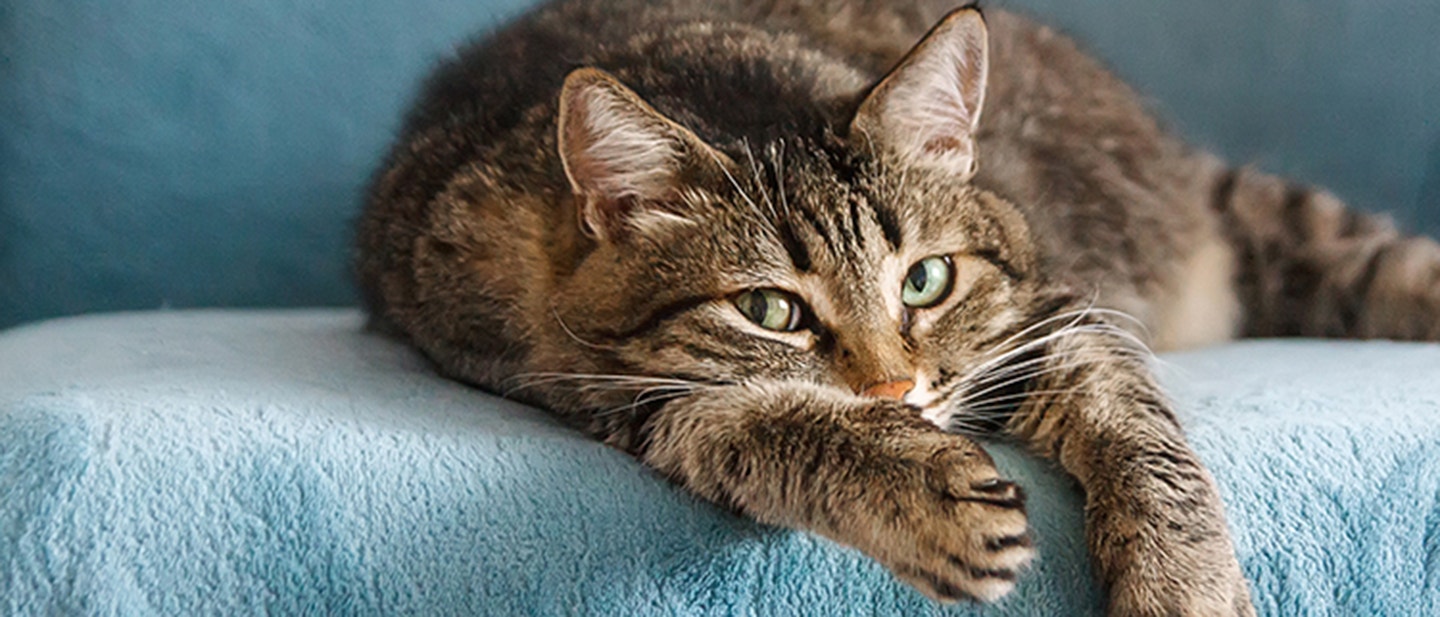
HOW LONG ARE CATS IN HEAT?

Article checked by a vet
The “Heat cycle” (sometimes referred to as being 'in season') relates to the “Oestrous cycle” of the female cat. This cycle occurs when a female cat has reached sexual maturity, which can be anytime from as young as just 4 months old. It is during this cycle that the female cat becomes fertile and is receptive to mating.
Many cat owners wonder “How long are cats in heat?” once their cat starts displaying certain behaviours. Knowing about the heat cycle is important before you welcome a new kitten into your home, as sexually mature female cats enter heat from 4-12 months old. Unless you are planning to breed from your cat, we recommend spaying/neutering. Your local vet will help you decide when the best time is for your kitten, normally from 4-6 months of age.
Kittens aren't fully grown and considered adults until 12 months of age, despite being sexually mature at just 4 months old, it is not recommended for a cat to have a litter of kittens until she is fully grown.
How often do cats go into heat and how long is a cat in heat?
The average duration of a cat's heat cycle can vary from 7 to 10 days. However, how long cats are in heat can range from as few as 1-2 days or even as long as 3 weeks in some cases. They are seasonally polyestrous, meaning that cats can go into heat several times during a season.
Signs your cat is in heat and here is how to help them
There are several tell-tale signs to look for that can teach you how to read your cat's mood if you suspect your pet may be in heat. Physical behaviours that could indicate your cat is in her fertile period include
- Loud vocalising
- Excessive grooming (genital area)
- Restlessness
- Loss of appetite
- Urine spraying
- Scratching
- Demanding affection
- Wanting to go outdoors
- Certain movements (rubbing against the floor)
- Holding her tail to one side
- Presenting rear upwards
There are many ways you can improve your cat's mood and distract her from any discomfort she may feel while she is in heat, this includes spending quality time with her and giving your pet lots of extra affection in the form of petting.
Incorporating new toys or games into your cat’s play routine, introducing scratching posts and dedicating safe outside space for her to explore (in the form of a ”catio”), are all great ways to improve your pet's overall mood during the heat cycle.
Male cats roam far and wide to seek out females in heat, therefore it is highly recommended that you try to keep your cat or kitten indoors during their heat cycle! This will stop male cats from interacting with your female cat and help prevent males from wandering too far from home.
Factors influencing cats heat cycle duration
Various internal and external influences affect the frequency and duration of a cat's oestrous cycle and how long cats are in heat. Cats are seasonally polyestrous, so they have multiple heat cycles during the season. The timing of a cat’s breeding season depends on geographical factors like daylight hours and temperature. For example, some indoor cats may cycle all year around.
Breed, age, weight, temperature, medical conditions and stress can all affect the heat cycle in different ways.
Cats have their first cycle during puberty, which can occur at 4-12 months. Hot temperatures can cause cats to cycle all year round rather than seasonally.
Heat cycles can cause cats to lose weight due to the energy exerted. Medical conditions and stress may be a factor in your cat not going into heat, or entering persistent heat, a continuous cycle caused by a hormonal regulation condition when the cat does not find a mate.
Stages of Oestrous cycle in cats
The oestrous cycle, or “heat cycle” refers to a series of physiological changes that occur in female cats, which enables them to mate and reproduce. It has five important stages which indicate how long a cat can stay in heat.
Proestrus:
Not many signs are noted at this early stage. Proestrus refers to the period when the female cat may be attractive to the male but is not yet ready to mate. This typically lasts 1-2 days.
Oestrus:
This is when the female becomes ready to mate during the reproductive cycle. Physical changes can include red discharge, however, estrus is most easily recognisable via behavioural changes that are visible in your pet. These signs include excessive vocalisation, lifting the hind legs off the floor and rubbing across surfaces. Some vocalisations may sound like your pet is in pain.
Interestrus:
This refers to the period in between breeding cycles when your cat cannot reproduce. Usually lasts 2-3 weeks. Normal behaviour should resume during this stage.
Diestrus:
This stage refers to the period of time after mating. Diestrus occurs after Oestrus and generally lasts around 30-40 days, it typically accompanies the cycle's luteal phase. When an ovulating female cat enters the diestrus, the female cat becomes unresponsive to the male. Subsequently, if the female cat has become pregnant the pregnancy will last 60-64 days.
Anestrus:
This term refers to the period in between cycles when a cat cannot become pregnant. Anestrus usually lasts 2-3 months.
At what stage can my cat get pregnant?
When can a cat get pregnant? The only time that your cat can become pregnant is during the oestrous cycle.
A female cat will come into heat several times a year, before and during this time males will be attracted to the female, however, her receptiveness and willingness to mate will be the key signal that she has entered the heat cycle. Owners should also look for behavioural changes that indicate if their cat has entered the heat cycle. These signs include excessive vocalisations like wailing, yowling and meowing, some vocalisations may sound like your pet is in pain. Other physical signs include lifting their hind legs off the floor and rubbing their body across surfaces. Your pet may also arch their back or excessively groom themselves.
Due to the nature of the heat cycle, cat owners need to understand how to manage their pet's cycles before introducing a new pet into their home. If you have no intention of breeding your cat, spaying your pet may be the kindest option as entire cats can continue to go into heat well into their senior years.
The benefits of spaying include: preventing unwanted litters, reducing health risks associated with repeated oestrous cycles, reducing the risks associated with cats roaming far from home and limiting your pet’s potential discomfort.
How to prevent your cat from going on heat?
As mentioned previously, spaying is the primary and most effective way to halt heat cycles in cats and it has many health benefits. These health benefits include reducing the risk of cancer in the mammary glands. It will also have a huge impact on the overall behaviour and happiness of your pet, continuous heat cycles that do not result in pregnancy can be stressful not only for your pet but for you too! Spaying your pet will help avoid destructive or disruptive behaviours like howling and spraying.
There are also ways to limit external triggers if you have decided not to spay your pet, these include keeping your pet indoors and away from the attention of males. Dimming lights and closing curtains can also help calm them. Ultimately, creating a calming environment is paramount but it will depend on what your cat prefers e.g. more petting or leaving your cat to relax and do their own thing!
Having a consistent daily routine for your cat and a calm environment to help manage stress levels, which are heightened during heat, is key. Keeping your pet active and agile is another way to dispel the extra energy that may build up during heat cycles.
Frequently asked questions about cats in heat?
Responsible pet owners need to be knowledgeable about the heat cycle if they have an unspayed female cat. How long cats are in heat and how often cats are in heat can vary, so monitoring your pet’s heat cycle is recommended. Cats start entering heat from 4-12 months old, several times a year, for several days/weeks at a time.
This differs from other species like dogs which are monoestrous animals, meaning they go in heat once (or twice) a year. Cats are polyestrous animals, meaning that they enter heat multiple times a year.
This lengthy reproductive life cycle, the frequency of heat cycles and the disruptive nature of a female cat in heat are important factors to consider when deciding if you are going to breed or spay your family pet.
Behavioural and physical changes will usually indicate when your cat has gone into heat and when the heat has finished. The most common changes to be aware of are: howling, spraying, trying to get outside, rubbing the body across the floor etc.
As mentioned previously, if you have no intention of letting your pet become pregnant it is advisable to get them spayed as soon as possible.
Having a consistent daily routine, a calm environment to help manage stress levels during heat, and keeping your pet mentally stimulated (and away from windows and doors) are some of the best ways to manage heat-related behavioural changes.
Looking to learn more about your feline friend? We cover everything from managing your cat’s nutritional needs to how to care for your pet across our site.
Everything you need to know about your cat being in heat
The heat cycle is fascinating to learn about but it can be a stressful time for you and your pet. If you are not spaying your cat it’s your responsibility to prepare for the first heat cycle before your kitten goes into heat so you can manage their comfort levels and minimise any unwanted behaviour ahead of time. Use our handy guide to help you along the way or take your kitten to their vet to be spayed when they are around 4 months old (before their first heat cycle) to avoid unwanted litters and behaviour altogether!
